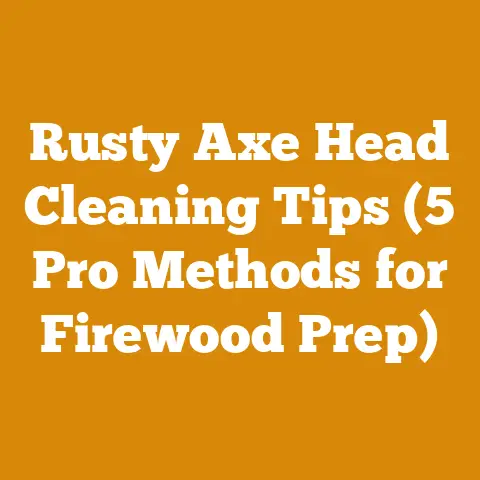What Size Wood Chipper Do I Need? (Pro Tips for Arborists)
What Size Wood Chipper Do I Need? Pro Tips for Arborists
Let’s dive right in, shall we? Choosing the right wood chipper is a bit like picking the perfect chainsaw – size matters, but it’s also about power, efficiency, and knowing exactly what you’re up against. As an arborist myself, I’ve seen firsthand the frustration of using a chipper that’s either too small and constantly getting bogged down or too large and guzzling fuel like there’s no tomorrow.
This guide is designed to help you navigate the often-confusing world of wood chippers. We’ll explore the different sizes, power options, and features, all while keeping a close eye on the bottom line. Because let’s face it, in this business, every dollar counts.
Understanding Your Chipping Needs
Before we even think about horsepower or infeed openings, we need to get crystal clear on what kind of work you’ll be doing. This is where honest self-assessment comes into play.
Project Scope: Small Residential vs. Large Commercial
Are you primarily tackling small residential jobs – pruning, trimming, and the occasional tree removal for homeowners? Or are you running a full-fledged arborist service, handling large-scale tree clearing, storm cleanup, and commercial property maintenance?
Residential Arborists: If you’re mainly dealing with smaller branches and limbs, a smaller, more portable chipper might be the perfect fit. These are typically less expensive to purchase and operate, and they’re easier to maneuver in tight spaces.
Commercial Arborists: For larger operations, you’ll need a chipper that can handle larger diameter logs and higher volumes of material. These machines are generally more powerful, more durable, and capable of working continuously for extended periods.
Types of Wood You’ll Be Chipping
The type of wood you’ll be processing is another critical factor. Softwoods like pine and fir are generally easier to chip than hardwoods like oak and maple. Knotty wood, regardless of species, can also present a challenge.
Softwoods: These are generally easier on chipper blades and require less horsepower to process.
Hardwoods: Demands more power and sharper blades. Requires more frequent blade sharpening or replacement.
Considerations: If you’re regularly dealing with hardwoods, you’ll want to invest in a chipper with a robust engine and a durable cutting system.
Volume of Chipping
How much material will you be chipping on a daily or weekly basis? This will help you determine the throughput capacity you need.
Occasional Use: If you only need to chip occasionally, a smaller, less expensive chipper might suffice.
High-Volume Use: If you’re chipping constantly, you’ll need a chipper that can keep up with the demand. Consider investing in a larger, more powerful machine with a high throughput capacity.
Wood Chipper Sizes: A Detailed Overview
Now that we’ve assessed your needs, let’s take a closer look at the different sizes of wood chippers available.
Small Wood Chippers (Up to 3-Inch Capacity)
These chippers are typically powered by gasoline engines ranging from 5 to 10 horsepower. They’re ideal for homeowners and small landscaping businesses that need to chip small branches and twigs.
Pros:
- Affordable: These are the least expensive chippers on the market.
- Portable: They’re lightweight and easy to move around.
- Easy to Use: Simple controls and straightforward operation.
Cons:
- Limited Capacity: Can only handle small diameter branches.
- Slow Throughput: Not suitable for high-volume chipping.
- Less Durable: Not designed for heavy-duty use.
Cost: Expect to pay between $500 and $2,000 for a small wood chipper.
Medium Wood Chippers (4- to 6-Inch Capacity)
These chippers are powered by gasoline engines ranging from 10 to 25 horsepower. They’re a good choice for homeowners with larger properties, small tree service companies, and rental businesses.
Pros:
- Versatile: Can handle a wider range of branch sizes.
- Good Throughput: Can chip a decent amount of material in a reasonable amount of time.
- More Durable: Built to withstand more frequent use.
Cons:
- More Expensive: Cost more than small chippers.
- Less Portable: Heavier and more difficult to move around.
- Requires More Maintenance: More complex engines and cutting systems require more maintenance.
Cost: Expect to pay between $2,000 and $10,000 for a medium wood chipper.
Large Wood Chippers (6-Inch and Up Capacity)
These chippers are powered by gasoline or diesel engines ranging from 25 horsepower to over 100 horsepower. They’re designed for professional arborists, logging companies, and municipalities that need to chip large diameter logs and high volumes of material.
Pros:
- High Capacity: Can handle large logs and branches with ease.
- Fast Throughput: Can chip a large amount of material quickly.
- Extremely Durable: Built to withstand heavy-duty use in demanding environments.
Cons:
- Very Expensive: These are the most expensive chippers on the market.
- Not Portable: Typically mounted on trailers and require a truck to tow.
- Requires Significant Maintenance: Complex engines and cutting systems require specialized maintenance.
Cost: Expect to pay between $10,000 and $100,000+ for a large wood chipper.
Key Features to Consider
Beyond size, there are several other features to consider when choosing a wood chipper.
Engine Type (Gasoline vs. Diesel)
Gasoline Engines: These are typically less expensive to purchase and maintain, and they’re readily available. However, they tend to be less fuel-efficient and have a shorter lifespan than diesel engines.
Diesel Engines: These are more fuel-efficient, more durable, and offer more torque than gasoline engines. However, they’re more expensive to purchase and maintain.
My Experience: For smaller chippers, gasoline engines are usually the way to go. But for larger, more demanding applications, a diesel engine is a worthwhile investment.
Infeed System (Gravity Feed vs. Hydraulic Feed)
Gravity Feed: These chippers rely on gravity to pull the material into the cutting blades. They’re simple and less expensive, but they require more manual effort to operate.
Hydraulic Feed: These chippers use hydraulic rollers to pull the material into the cutting blades. They’re more efficient and require less manual effort, but they’re also more expensive.
Pro Tip: A hydraulic feed system is a game-changer, especially when dealing with larger branches or awkward shapes.
Cutting System (Disc vs. Drum)
Disc Chippers: These chippers use a rotating disc with knives mounted on it to chip the material. They’re generally more efficient and produce a more uniform chip size.
Drum Chippers: These chippers use a rotating drum with knives mounted on it to chip the material. They’re less expensive than disc chippers, but they can be more prone to clogging.
Considerations: Disc chippers are generally preferred for their efficiency and chip quality.
Safety Features
Safety should always be a top priority when operating a wood chipper. Look for features like:
- Emergency Stop Bar: Allows you to quickly shut down the chipper in case of an emergency.
- Infeed Table Extensions: Provide a safe distance between the operator and the cutting blades.
- Safety Glasses and Hearing Protection: Essential for protecting your eyes and ears.
Remember: Always read and follow the manufacturer’s safety instructions before operating a wood chipper.
Cost Breakdown: Purchase, Operation, and Maintenance
Okay, let’s talk money. Owning and operating a wood chipper involves several costs, including:
Purchase Price
As we discussed earlier, the purchase price of a wood chipper can range from a few hundred dollars to over $100,000, depending on the size and features.
Financing Options: Many manufacturers offer financing options to help you spread out the cost of a new chipper.
Used Equipment: Consider purchasing a used chipper to save money. However, be sure to thoroughly inspect the machine before you buy it to ensure that it’s in good working condition.
Fuel Costs
Fuel costs can be a significant expense, especially for larger chippers. The amount of fuel you’ll use will depend on the size of the engine, the type of wood you’re chipping, and the amount of time you’re operating the chipper.
Data Point: A 50-horsepower diesel chipper can burn through 3-5 gallons of fuel per hour. At an average diesel price of $4.00 per gallon, that’s $12-$20 per hour in fuel costs alone.
Cost Optimization: To reduce fuel costs, keep your chipper well-maintained, use the correct fuel type, and avoid idling the engine unnecessarily.
Maintenance Costs
Wood chippers require regular maintenance to keep them running smoothly. This includes:
- Blade Sharpening or Replacement: Dull blades can reduce chipping efficiency and increase fuel consumption.
- Oil Changes: Regular oil changes are essential for keeping the engine running smoothly.
- Filter Replacements: Air filters and fuel filters need to be replaced regularly.
- Greasing: Moving parts need to be greased regularly to prevent wear and tear.
Statistical Data: According to industry averages, annual maintenance costs for a wood chipper can range from 5% to 10% of the purchase price.
Cost Management: To minimize maintenance costs, follow the manufacturer’s recommended maintenance schedule, use high-quality parts, and perform routine inspections.
Repair Costs
Even with regular maintenance, wood chippers can break down. Repair costs can vary widely depending on the type of repair needed.
Common Repairs: Common repairs include engine repairs, hydraulic system repairs, and cutting system repairs.
Cost Estimation: To estimate potential repair costs, get quotes from several qualified mechanics.
Budgeting: Set aside a contingency fund to cover unexpected repair costs.
Labor Costs
If you’re hiring employees to operate the chipper, you’ll need to factor in labor costs.
Wage Rates: Wage rates for chipper operators vary depending on location and experience.
Productivity: The number of employees you’ll need will depend on the size of the job and the efficiency of the chipper.
Cost Optimization: To optimize labor costs, train your employees properly, use efficient work methods, and ensure that the chipper is well-maintained.
Renting vs. Buying: Which is Right for You?
Deciding whether to rent or buy a wood chipper is a big decision. Here’s a breakdown to help you weigh your options:
Renting
Pros:
- Lower Upfront Cost: Renting eliminates the need for a large initial investment.
- Access to Different Sizes: You can rent the right size chipper for each job.
- No Maintenance Responsibilities: The rental company is responsible for maintenance and repairs.
Cons:
- Higher Long-Term Cost: Renting can be more expensive in the long run if you use the chipper frequently.
- Limited Availability: The chipper you need may not always be available when you need it.
- Rental Fees: You’ll have to pay rental fees even when you’re not using the chipper.
Buying
Pros:
- Lower Long-Term Cost: Buying can be more cost-effective in the long run if you use the chipper frequently.
- Availability: You’ll always have access to the chipper when you need it.
- Equity: You’ll own an asset that you can sell later.
Cons:
- Higher Upfront Cost: Buying requires a large initial investment.
- Maintenance Responsibilities: You’re responsible for maintenance and repairs.
- Depreciation: The value of the chipper will depreciate over time.
Decision-Making: If you only need a wood chipper occasionally, renting is probably the better option. But if you plan to use it frequently, buying is likely the more cost-effective choice.
A Personal Anecdote: Early in my career, I rented a chipper for a large storm cleanup project. While it got the job done, the rental fees quickly added up. I realized that buying a chipper would have been a much smarter investment in the long run.
Budgeting for Your Wood Chipper Project
Now that we’ve covered the various costs involved, let’s talk about how to create a budget for your wood chipper project.
Step 1: Estimate the Scope of the Project
Start by estimating the amount of material you’ll need to chip. This will help you determine the size of chipper you’ll need and the amount of time it will take to complete the project.
Step 2: Research Rental or Purchase Costs
Get quotes from several rental companies or dealers for the type of chipper you need. Be sure to factor in any delivery or setup fees.
Step 3: Estimate Fuel Costs
Estimate the amount of fuel you’ll need based on the size of the engine and the amount of time you’ll be operating the chipper.
Step 4: Estimate Labor Costs
If you’re hiring employees to operate the chipper, estimate the labor costs based on wage rates and the amount of time it will take to complete the project.
Step 5: Estimate Maintenance Costs
Estimate the maintenance costs based on the manufacturer’s recommended maintenance schedule.
Step 6: Add a Contingency Fund
Add a contingency fund to cover unexpected expenses, such as repairs or delays.
Step 7: Calculate the Total Cost
Add up all of the estimated costs to calculate the total cost of the project.
Example Budget:
- Chipper Rental (1 week): $1,000
- Fuel Costs: $200
- Labor Costs: $800
- Maintenance Costs: $50
- Contingency Fund: $200
- Total Cost: $2,250
Tips for Budget Management:
- Track your expenses carefully.
- Look for ways to reduce costs.
- Be prepared for unexpected expenses.
Pro Tips for Arborists
Here are a few extra pro tips to help you get the most out of your wood chipper:
Blade Maintenance
- Sharpen or replace your chipper blades regularly to maintain optimal performance.
- Use a high-quality blade sharpener to ensure that the blades are sharpened correctly.
- Store your blades in a safe place to prevent damage.
Chipper Maintenance
- Follow the manufacturer’s recommended maintenance schedule.
- Use high-quality parts and fluids.
- Perform routine inspections to identify potential problems early.
- Keep the chipper clean and free of debris.
Safety Practices
- Always wear safety glasses and hearing protection when operating a wood chipper.
- Keep your hands and feet away from the cutting blades.
- Never operate the chipper under the influence of drugs or alcohol.
- Read and follow the manufacturer’s safety instructions.
Wood Handling
- Remove any nails, screws, or other metal objects from the wood before chipping it.
- Cut branches to a manageable length before feeding them into the chipper.
- Feed the wood into the chipper slowly and steadily.
- Avoid overloading the chipper.
Case Studies: Real-World Examples
To further illustrate the importance of choosing the right wood chipper, let’s take a look at a few real-world case studies:
Case Study 1: Residential Arborist
A residential arborist was using a small, underpowered chipper for tree trimming jobs. The chipper was constantly getting bogged down, and the arborist was spending a lot of time clearing jams. As a result, the arborist was losing time and money.
Solution: The arborist upgraded to a medium-sized chipper with a hydraulic feed system. The new chipper was much more efficient, and the arborist was able to complete jobs much faster.
Case Study 2: Commercial Arborist
A commercial arborist was using an old, outdated chipper for tree clearing projects. The chipper was unreliable and required frequent repairs. As a result, the arborist was experiencing significant downtime.
Solution: The arborist invested in a new, high-capacity chipper with a diesel engine. The new chipper was much more reliable, and the arborist was able to reduce downtime and increase productivity.
Case Study 3: Firewood Supplier
A firewood supplier was using a small chipper to process scrap wood into mulch. The chipper was slow and inefficient, and the supplier was struggling to keep up with demand.
Solution: The firewood supplier purchased a larger chipper with a higher throughput capacity. The new chipper was able to process the wood much faster, and the supplier was able to increase production and meet demand.
Actionable Takeaways and Next Steps
Choosing the right wood chipper is a critical decision for any arborist or wood processing professional. By carefully considering your needs, understanding the different sizes and features available, and budgeting for the various costs involved, you can make an informed decision that will save you time, money, and frustration.
Actionable Takeaways:
- Assess your chipping needs carefully.
- Research different chipper sizes and features.
- Consider renting versus buying.
- Create a budget for your project.
- Prioritize safety.
- Maintain your chipper properly.
Next Steps:
- Evaluate your current and future wood chipping needs. Consider the size and type of wood you’ll be processing, the volume of material you’ll be chipping, and the frequency of use.
- Research different wood chipper models and brands. Read reviews, compare specifications, and get quotes from several dealers.
- Visit a local dealer to see the chippers in person. Ask questions and get a demonstration of how the chippers operate.
- Create a detailed budget for your project. Include the purchase price or rental fees, fuel costs, labor costs, maintenance costs, and a contingency fund.
- Make a decision and purchase or rent the right wood chipper for your needs.
By following these steps, you can choose the right wood chipper for your business and ensure that your wood processing projects are efficient, safe, and profitable. Remember, it’s an investment that will pay off in the long run, allowing you to tackle jobs with confidence and efficiency. Happy chipping!






